Text
Burberry- right in the middle?

Like many other luxury retail brands, Burberry has also suffered from over-licensing and broad, inconsistent distribution networks.
The first decision Bravo and her team made was to reposition the brand, the goal being to attract younger customers while retaining Burberry’s core customer base. Bravo eventually decided that there was a niche for Burberry between labels such as Polo Ralph Lauren and Giorgio Armani in apparel, and between Coach and Gucci in accessories. They wanted Burberry to represent ‘accessible luxury.’
Bravo and her team had reined in many of the older licensing agreements to curb inconsistencies in price, design, and quality across markets.
The company had also taken tighter control over distribution—buying some distributors, ending relationships with some, and renegotiating contracts with others.
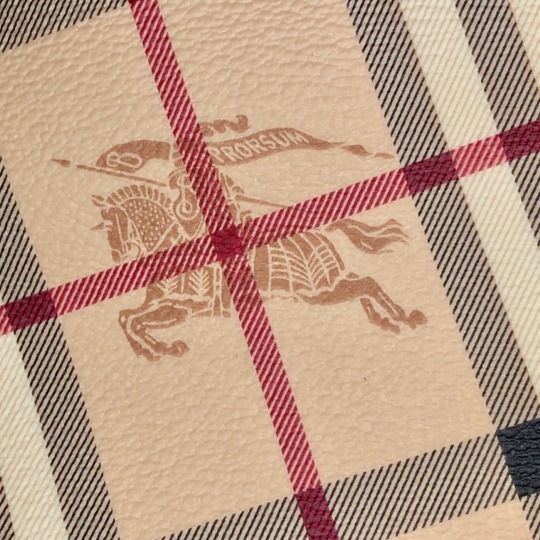
Several of the challenges that Bravo faced are challenges that both Coach and Gucci also had to address in the past. What is somewhat distinct about Burberry is the association with defending the Burberry check and preserving the value of the check by limiting supply. Coach was also very well-known for its “C” logo, which was placed on many of its handbags. The overuse of this logo combined with Coach’s significant presence in department stores that regularly ran promotions decreased the value of Coach’s brand. Gucci was also plagued with an overabundance of licensees and a loosely monitored distribution network. To improve its position in the luxury market, both brands decreased its amount of licenses and revamped the product assortment.
Burberry check was once a fashionable style, but it’s not something that lingered for a long time. Burberry needs to stick with a firm grasp of their overall aesthetic which I would best describe as sophisticated luxury utility, and not put the pattern on everything from hats and handbags to bikinis.

I was also curious to know what is the cheapest Burberry product you can buy. Watching the fashion blogger, Annalise Wood (https://www.youtube.com/watch?v=KBwc6Ls2JTs), I learned that it’s just an eyeliner. However, Burberry’s prestigious, very “Instagramly” package and wrapping, makes you believe that you have just bought the most luxury product ever, with your limited student budget. Burberry’s strategies, to penetrate the middle market by expending their accessories line, expose young people to the brand and create more attention and curiosity. Having Burberry hat, belt or even phone case is a new status symbol that everyone wants these days.

0 notes
Text
Who will win the race of diffusion ?
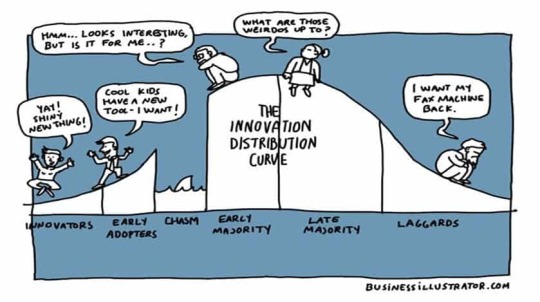
One job of product managers, marketers, strategic planners, and other corporate executives is to predict what the demand will be for a new product. For new-to-the-world products, it is much more difficult to predict consumer acceptance (at least in the short run).
The growth of mainstream adoption raises the question of how difficult it is to forecast adoption of new products. For example, Why did Zoom became a household name and one of the most popular apps during the COVID?
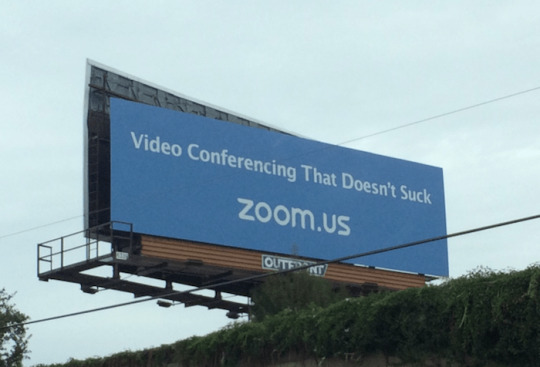
There are five attributes of an innovation that can be used to predict the diffusion rate of a future product, also known as Roger’s Five Factors:
Relative advantage
Compatibility
Complexity
Trialability
Observability
My rank of the four innovations (in terms of how rapidly and broadly they will diffuse in the marketplace):
First Place: Individually wrapped peanut butter slices:
Spreading peanut butter on bread can be frustrating. The product is very easy to use, accessible and probably affordable to everyone; little kids to take it with them or to roll around a piece of fruit. It’s more more convenient and has a huge demand in the American market. It has no strong competitors and thus enjoy a competitive advantage in the Peanut Butter market. The product also can be easily distributed for trial at local supermarkets or retailers. WalMart and Albertson seems to be a great way to distribute the product, penetrating the mass market.
Second Place: Stave Puzzles: the puzzles introduce a whole new experience and that is very tempting to try. It can be formed a number of ways, but only one permutation is correct. On the other hand, Richardson designed these Trick puzzles with his "sharpy" customers in mind, those [odd few] who relish the opportunity to spend great quantities of money and time on aggravation
Although he aims for a very small market segmentation, it would become a great hit in the US with great marketing approach. I liked the idea that each Stave puzzle is initialed and dated by its cutter, and arrives in a handsome blue box, with just a handwritten clue to the image inside- very unique and interesting.The product provides high value to customers who enjoy the challenges and may define the new high-end puzzles category.
Third Place: Polytrack: The idea seems to be innovative and promising (horses are generally coming out of races in good condition and are bouncing back faster with less injuries), but the market seems to be too small to spread the word. Collins found more receptive audience in England and later in other places in the US, but I’m not sure it would be enough. A pivot to soccer/ football fields, for example, could add more value and increase the potential. As for the customers, the ROI is projected to be high and once it is adopted, it would create a new standard in the field.
Fourth Place: Collapsible bike wheel: Initial models will probably cost between $2,000 and $6,000. I stopped there.
0 notes
Text
Is There a Right Way to Nudge?
“There’s no such thing as ‘neutral’ design. Small and apparently insignificant details can have major impacts on people’s behavior.” — Richard H. Thaler

A nudge makes it more likely that an individual will make a particular choice, or behave in a particular way, by altering the environment so that automatic cognitive processes are triggered to favour the desired outcome.
An individual’s behaviour is not always in alignment with their intentions. It is common knowledge that humans are not fully rational beings; that is, people will often do something that is not in their own self-interest, even when they are aware that their actions are not in their best interest. As an example, when hungry, people who diet often underestimate their ability to lose weight, and their intentions to eat healthy can be temporarily weakened until they are satiated.
Here are some of the most clever nudges I could find:
1) Speed Camera Lottery: In 2010, Volkswagen picked Kevin Richardson as the winner of its Fun Theory Contest. Richardson invented the “Speed Camera Lottery,” which uses the speeding cameras at intersections to reward those who obey the speed limit with the fees paid by those who violated it.

2) Reducing cigarette litter on the streets of London- Football fans are known to have very strong opinions on who’s the #1 player of the world. Environmental organization Hubbub took advantage of this in a brilliant way.The innovative ashtrays have proven to reduce cigarette litter by 46%.
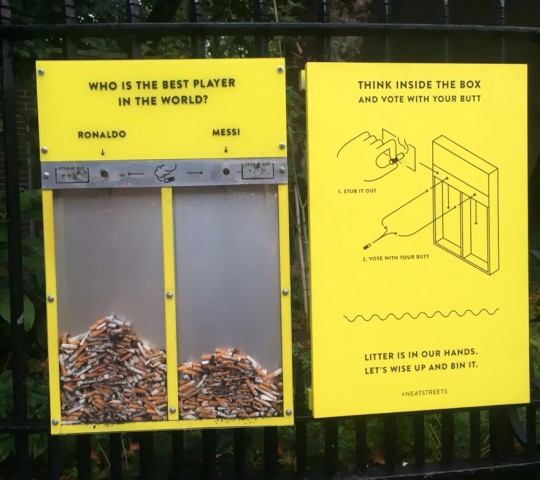
3) Bleep — Honk Reduction System- A simple intervention to reduce indiscriminate honking on Indian roads. Every time the driver honks, a red smiley button starts beeping and flashing. To turn it off, the driver has to press the button. In other words, the button makes the subconscious habit of indiscriminate honking conscious again by giving immediate feedback to the driver.

4) The Famous Piano Stairs- The piano stairs encourage subway commuters to ditch the escalators and go for the healthier option: climbing the stairs. It shows that something as simple as fun is the easiest way to change people’s behavior for the better.

The Future of Nudging:
As I see it, nudging is inexpensive way to manipulate on the customers behavior. But, todays’ Nudge (v1.0) is mostly about using behavioral insights to influence single decision points: for example, getting people to become an organ donor, or show up for their flu shot. The new Nudge practices however, (v2.0) will be about changing decisions in a more lasting way. In other words, not just single decisions but daily decisions like exercise, eating, saving, and spending. It’s harder to change someone in a more enduring way than to just change or shape a single decision when you have their attention. But it’s an important goal given how many of our decisions are small and repeated, and end up having big consequences.
2 notes
·
View notes
Text
Corona Beer Virus?

There’s nothing I miss more than squeezing a lime into cold Corona’s long-neck bottle on Tel Aviv’s beach in a sunny day, a ritual that became one of Corona’s differentiating characteristics (“Corona and lime”). Corona’s advertising theme had emphasized the “Fun, Sun, Beach” theme since its inception. Ads are filmed in Mexico and keep simple. They usually portray a beach environment, with little or no music, and no voiceover. There are no full images of people in the ads.
However, Corona Beer recently got linked to the deadly Coronavirus. Being linked to something like the coronavirus is something you absolutely don’t want as a brand. The name coronavirus comes from the Latin word corona, meaning crown or halo. Under an electron microscope, the image of the virus is reminiscent of a solar corona. It is very unfortunate, but there is nothing Corona beer can do about it.

A recent survey of American beer drinkers found that 38% of those asked will not buy Corona beer and 16% are confused if Corona beer is related to the coronavirus
However, Coronavirus fears haven’t sunk sales of Corona Beer in U.S: Corona Extra sales grew 5% in the U.S. in the latest two months —nearly doubling the 52-week trend for the brand. Corona’s sales are heavily dependent on the US market, unlike some of its far-more-international rivals. When the company was asked about it, they said: “Our advertising with Corona is consistent with the campaign we have been running for the last 30 years and is based off strong consumer sentiment.”
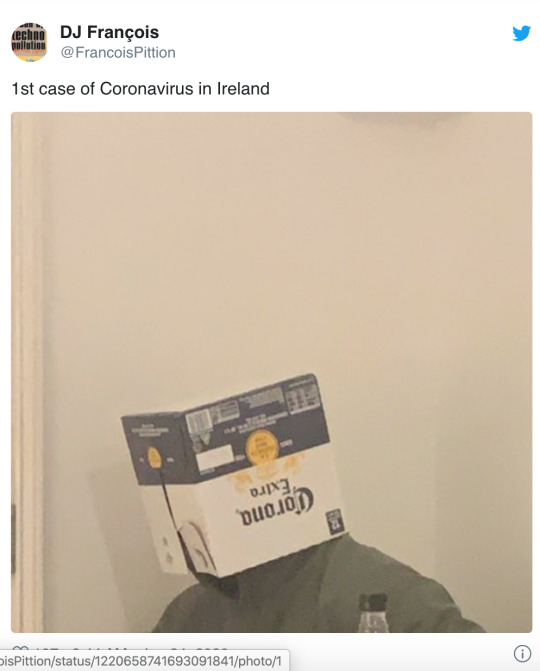
Corona and Heineken:
The two brands have a very different marketing approaches: Corona is focused on the theme of pleasant times spent in Mexico. Modelo’s advertising stressed the “fun” nature of Corona, highlighting its packaging, unpretentiousness, and taste. Supported by consistent advertising and marketing campaigns, the premium image was established. Heineken didn’t have an official marketing function until 1990s; They had historically emphasized quality, and it’s ads portrayed at the beginning competing beers as faddish phenomena, focusing on product quality. New ads made no mention of the product’s benefits or of its number one status and humor was built in, and it was bound to be more market-driven than product-driven. It left them arrogant and haughty, leaving an opportunity for insurgents like Corona. On the other hand, however, Corona’s over-reliance on a warm-weather beach schema could open it to a risk of weak sales outside the summer months.
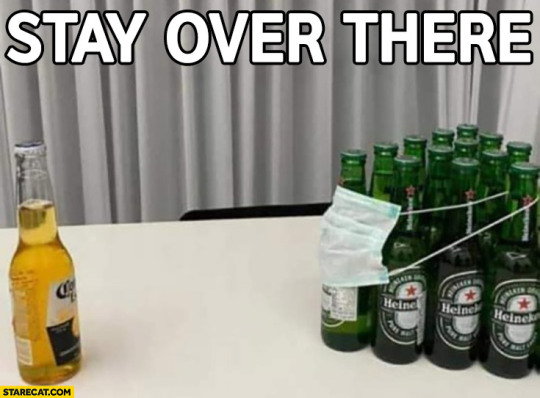
1 note
·
View note
Text
Don't judge a PC by its cover
One of my first strong memories as a child is the bold sticker on my first computer stating “Intel Inside”. I didn’t really realize what it means until I grew up, but I knew it means prestigious and quality.

Intel’s Red X campaign was successful in promoting a product that, by 1989, was already obsolete. With new products slated to be introduced every other year or so, the team quickly realized that the company could not afford to brand each new generation of product that was released. The solution was to create an umbrella brand that could span successive generations of products.
Intel wanted also to raise the awareness to their microprocessors, to let customers understand its importance within the computer.
All of Intel’s advertising was designed to explain why having “Intel Inside” was important. The two attributes that Intel wanted people to associate with the brand were safety (reliability) and leading technology. Their campaign elevated the level of awareness of a component of the PC, the” secret sauce”, that was neglected by end users and established the Intel brand image, leading to repeat purchases and consumer advocacy, and eventually promoting the growth of the entire PC industry. As a consequence, Intel was ranked the sixth most valuable brand in the world, alongside consumer powerhouses such as Coke and Disney. Because of the campaign, the microprocessor has come to be viewed as a very important component of the PC. Also, they’ve always had a performance-based product that has delivered on their message.
I attribute their success to the fact that they could bridge over the technical part and approach people beliefs and desires. They knew exactly how to deliver the message, and used some great creative advertisement featuring the Blue Man Group and aliens: they focused more on the communicating with consumers about the Intel brand.
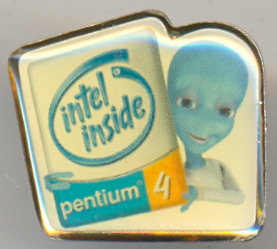
There are few challenges associated with this approach:
Maintaining a strong brand means that you need to align your product “roadmap” with its marketing roadmap- Intel’s strategy to counter competitors was to achieve an overwhelming performance advantage with successive generations of processors. In order to ensure that the company remained ahead of the technology curve, Intel instituted overlapping development cycles. Previously, the company had waited until one generation of microprocessor was ready for production before beginning development of the next generation. That could lead to half-baked products with many problems.
Growing a strong brand means also keeping it flawless. Intel was confronted with its first major product-related crisis when an end user discovered a minor flaw in the new Pentium processor- even though it was small, the flaw was highly publicized, causing a flurry of negative publicity.
Expecting cheaper alternatives that might grab market share- many cheaper substitutes products started to show up in the market and Intel was scrambling to respond. It made them to enter the low-end market with a weak, unknown brand (Celeron).
Finally, as PCs became an integral part of the lives of more people, it was important to keep the brand to be breakthrough, relevant, and innovative, so new marketing efforts were needed.
1 note
·
View note